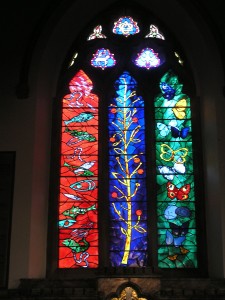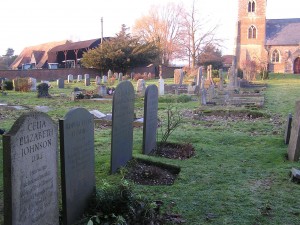After lunch with my enchanting, hospitable cousins at Nettlebed, Oxfordshire, we repaired to the adjacent churchyard. I was interested to see the grave of Peter Fleming (1907-1971), one of my literary heroes, as the epitaph inscribed on the headstone, composed by Fleming himself, is a particularly fine example of this art form.
He travelled widely in far places:
Wrote, and was widely read.
Soldiered, saw some of danger’s faces,
Came home to Nettlebed.
The squire lies here, his journeys ended –
Dust, and a name on a stone –
Content, amid the lands he tended,
To keep this rendezvous alone.
R.P.F.
Peter Fleming, who lived at Merrimoles House on his 2,000-acre estate at Nettlebed and was married to the actress Celia Johnson, is best known for his Brazilian Adventure (1933) and for accounts of his travels in Asia. His wartime service was with the Grenadier Guards and as head of ‘D’ Division in south-east Asia.
 In a single sheet of instructions headed ‘R.P.F.: FUNERAL ARRANGEMENTS’, Fleming anticipates that the epitaph ‘may require a “Faculty”, and involve a skirmish with ecclesiastical bureaucracy’, but any such impediments were, happily, overcome. This is said to have been ‘the only serious poem he ever wrote’. (Duff Hart-Davis, Peter Fleming: A Biography (London, 1974), pp.400-1.)
In a single sheet of instructions headed ‘R.P.F.: FUNERAL ARRANGEMENTS’, Fleming anticipates that the epitaph ‘may require a “Faculty”, and involve a skirmish with ecclesiastical bureaucracy’, but any such impediments were, happily, overcome. This is said to have been ‘the only serious poem he ever wrote’. (Duff Hart-Davis, Peter Fleming: A Biography (London, 1974), pp.400-1.)
Such panache even in death! Fleming was fortunate also to have John Piper as a near neighbour, who designed this beautiful stained-glass window (top) as his memorial in the church – and it boasts a second, even finer Piper window in memory of Dr Robin Williamson, also illustrated here (left).
The best epitaphs are those which cause one to pause and reflect on mortality. With incredible coolness and composure, Sir Walter Ralegh recast the final verses of his earlier poem, ‘Nature that washed her hands in milk’, on the eve of his execution in 1618. He is said to have left them ‘att the Gate howse’ of Whitehall Palace, as if intending them as an epitaph:
Even such is time which takes in trust
Our youth, our Joys, and all we have,
And pays us but with age and dust:
Who in the dark and silent grave
When we have wandered all our ways
Shuts up the story of our days.
And from which earth and grave and dust
The Lord shall raise me up I trust.
Perhaps the finest example of an epitaph in the English language is that of W.B. Yeats (1865-1939) on his headstone at Drumcliffe, County Sligo –
Cast a cold eye
On life, on Death.
Horseman, pass by!
– though these are actually the last lines of one of Yeats’s final poems, ‘Under Ben Bulben’, and were not composed specifically as an epitaph.
I have recently come across a touching epitaph from a place near Melitene (Malatya, Turkey) in the Byzantine period, when the local population were bilingual in Greek and Arabic and tolerant of each other’s religions. A stranger from what is now Iraq had settled there and had befriended a local man, possibly a doctor. When the stranger died, his friend had him buried according to Islamic custom – oriented towards Mecca – and had the following Arabic verses carved on his tomb:
I went on long journeys,
travelling hither and thither in search of wealth,
and the misfortunes of time overtook me,
as you can see.
I wish I knew whether my friends cried
when they lost me
or whether they even knew.
(From The Book of Strangers: Medieval Arabic Graffiti on the Theme of Nostalgia, trans. Patricia Crone and Shmuel Moreh (Princeton, 2000), p.40.)
However, the pithiest epitaphs are from the classical world, the most famous of all being that by Simonides, which, according to Herodotus, was inscribed on a slab on the burial-mound of the Spartans at Thermopylae:
Go tell them in Lacadaemon, passer-by,
That here, obedient to their word, we lie.


Thought my research for friend’s event at The Nettlebed Village Club might interest you. Love the Piper widows in the morning sunshine.
The Nettlebed Working Men’s Club, as it was originally known, was commissioned in 1912 by Robert Fleming (1845-1923) financier, of Joyce Grove, Nettlebed, now the Sue Ryder Care Home. The design is by Charles E. Mallows, (1864-1915), a leading Edwardian architect and landscape designer and cost £4,500. It is built of tiles and ‘blue’ brick made in the Nettlebed Estate brickworks and pottery. Much of the construction, including the iron fittings, was the work of local craftsmen. The building is considered one of the best of several designs in Oxfordshire of the international Arts and Crafts Movement which originated in England and flourished worldwide between 1880 up to the 1930s.
The Movement was inspired by the author John Ruskin (1819-1900) as a reaction against the impoverished state of the decorative arts. It also proposed social and economic reform and was seen essentially as anti-industrial. This may have been a reason for Robert Fleming providing this excellent recreational facility for his estate workers. Robert Fleming, a Scot from Dundee, was the grandfather of Peter Fleming world traveller and writer, and Ian Fleming author of the James Bond novels.
When the Club opened in 1913 it included a rifle range, skittle alley and billiards room. The two halls were used for dances and as a cinema for the new ‘silent’ films.
The spacious bar was strictly ‘men only’ although ladies were welcomed on Christmas Eve!
Malcolm Lewis. Nettlebed resident. Your post picked up by Google Alert.
Thanks for this – very interesting. Long live the Flemings!